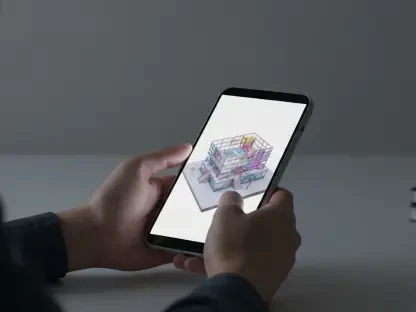What if the future of drone technology isn’t hidden in a high-tech lab but fluttering unnoticed in a backyard? Picture a drone so small it could slip through a keyhole, inspired by insects barely larger than a speck of dust, known as microbugs, with their peculiar feather-like wings that are not just a curiosity of nature but are revolutionizing how engineers approach the design of ultra-tiny drones. This exploration dives into a world where biology meets innovation, revealing how the smallest creatures could solve some of the biggest challenges in modern technology.
The Tiny Titans of Flight
The significance of this story lies in the urgent demand for smaller, more efficient drones across industries like search-and-rescue, surveillance, and environmental monitoring. Current designs struggle to shrink below a few centimeters due to limitations in power and flight mechanics. Yet, microinsects—measuring less than a millimeter—offer a proven natural model that defies these barriers with bristled wings that are lightweight and energy-efficient. Their unique anatomy isn’t just a scientific marvel; it’s a potential game-changer for creating unobtrusive tools capable of accessing spaces previously out of reach.
Decoding Nature’s Micro-Miracle
Deep in the realm of entomology, the bristled wings of microinsects stand out as an evolutionary masterpiece. Unlike the solid, membranous wings of larger insects like bees, these tiny fliers sport individual bristles spaced meticulously apart. At submillimeter scales, air behaves more like a thick syrup than a light breeze, creating immense drag. The feather-like structure counters this by slashing weight, allowing these insects to flap with minimal energy loss—a critical lesson for engineers aiming to mimic such efficiency.
Research into this design reveals a precision that’s almost mechanical. Bristles are typically spaced at intervals about ten times their diameter, striking a balance that prevents excessive air from slipping through while keeping the wing light. This spacing, combined with carefully tuned bristle length and thickness, ensures the wings don’t bend too much under pressure. It’s a natural engineering feat that outperforms many human-made solutions at these minuscule dimensions.
The Drone Dilemma at Micro Scales
Shrinking drones to the size of insects isn’t just a whimsical goal—it’s a pressing need for applications ranging from inspecting tight infrastructure to covert operations. However, current prototypes like Harvard’s RoboBee, spanning 3 centimeters, or the University of Pennsylvania’s Piccolissimo at 2.5 centimeters, hit a wall when it comes to further miniaturization. Battery constraints and inefficient propulsion systems make sustained flight a daunting hurdle, exposing a gap that traditional tech can’t yet bridge.
This is where nature’s blueprint becomes invaluable. The challenges of viscous air friction at tiny scales, which microinsects have already mastered, remain a stumbling block for artificial systems. By studying how these creatures navigate such conditions, developers can rethink wing design and energy use, potentially unlocking a new era of drones that are as small as they are stealthy.
Voices from the Cutting Edge
Experts are already buzzing with excitement over what microbug wings could mean for technology. Assistant Professor Dmitry Kolomenskiy from the Skolkovo Institute of Science and Technology notes, “Nature has spent millions of years perfecting flight at these scales—ignoring that would be a missed opportunity.” His research, alongside Senior Research Scientist Petr Petrov, highlights the mechanical brilliance of bristle spacing and flexibility as a direct inspiration for synthetic designs.
Petrov adds a practical perspective, stating, “Replicating the exact efficiency of these wings is tough, but even partial success could transform how we power and maneuver tiny drones.” Their findings, backed by detailed analysis of beetle wing structures, provide a solid foundation. Published studies show that this isn’t mere theory—comparisons across species confirm bristled wings are a deliberate adaptation for flight, not a random quirk, offering a reliable model for innovation.
Turning Insect Ingenuity into Tech Reality
Translating this biological marvel into functional drones requires actionable strategies. One approach focuses on crafting biomimetic materials that echo the lightweight strength of microbug wings. Advanced composites and microfabrication techniques could produce bristled structures that cut down on weight without sacrificing durability, a key step for extending flight times at tiny scales.
Another critical area is optimizing design through technology. Computational models can simulate bristle spacing and flexibility, targeting intervals that maximize lift while minimizing drag. Simultaneously, tackling power issues is essential—pairing these bio-inspired wings with emerging micro-batteries or energy-harvesting methods like ambient vibration capture could address the persistent bottleneck of energy supply.
Lastly, initial efforts should zero in on niche uses where small size offers a clear edge, such as monitoring confined spaces or discreet surveillance tasks. By proving the value in these specific scenarios, broader investment and development can be justified. Starting small, both literally and strategically, paves the way for scaling up the impact of insect-inspired drones across multiple fields.
Reflecting on a Small but Mighty Legacy
Looking back, the journey of uncovering microbug wing secrets has sparked a profound shift in how technology draws from nature’s playbook. The meticulous balance of bristle design has offered a glimpse into evolutionary solutions that outstrip many human attempts at micro-flight. Each discovery, from air friction mastery to weight reduction, has laid a stepping stone for what comes next.
Moving forward, the challenge rests on engineers and researchers to refine these insights into tangible tools. Collaborative efforts must prioritize sustainable power sources and scalable manufacturing to bring insect-sized drones from lab curiosity to real-world utility. As these tiny titans of nature have shown, sometimes the smallest ideas hold the power to reshape the vast landscape of innovation.









